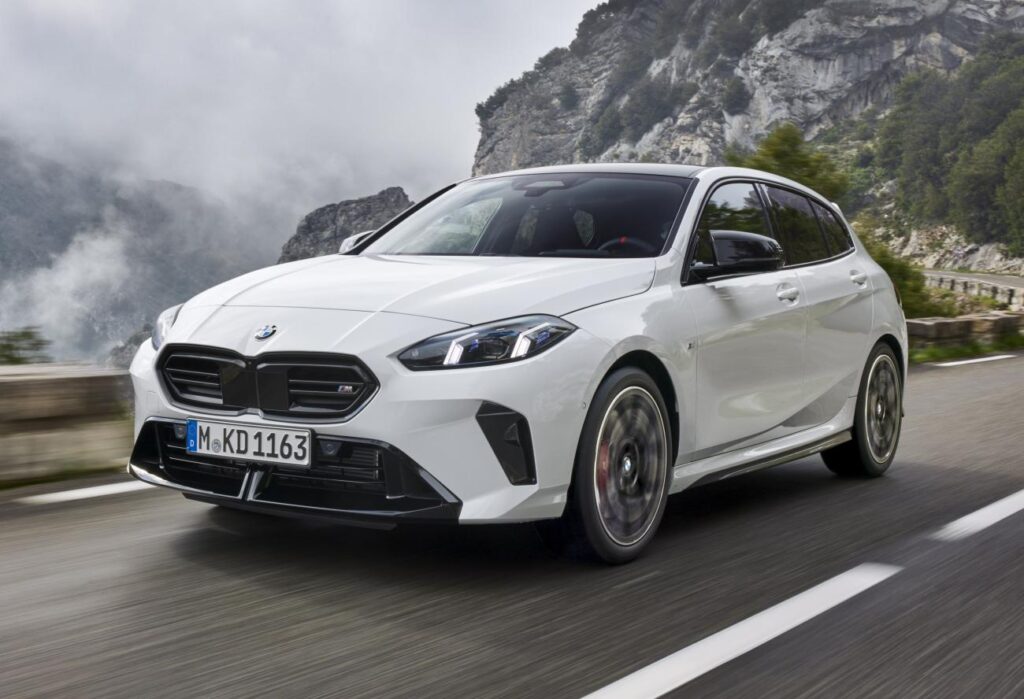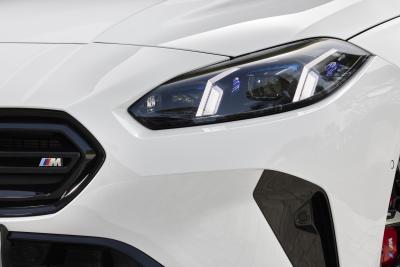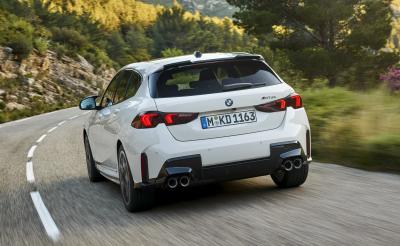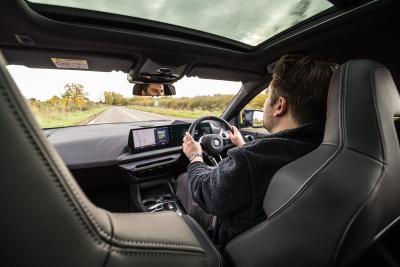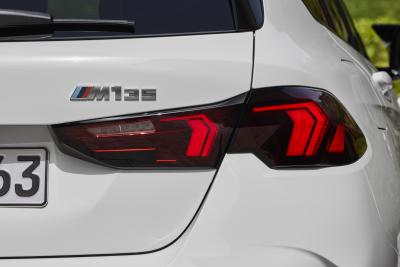They say there’s no ‘I’ in ‘team’, and now there’s no ‘i’ in ‘BMW M135’, either. The new 1-series is the first car launched under BMW’s new naming system, which sees the ninth letter of the alphabet, previously used to denote petrol-powered cars, applied exclusively to EVs. This has rubbed some people up the wrong way, but in fairness, it’s not as if BMW still needed to make the point that its cars are fuel-injected. It’s sort of been a given for nearly 40 years.
So it’s lost a syllable compared to the old M135i, and it’s also lost some grunt. Though it’s got the same engine – the B48 2.0-litre four-pot turbo – power’s dropped from 302 to 295bhp. Blame emissions regulations for that one. Torque’s taken a kicking, too, dropping from 331 to 295lb ft. All this means the 0-62mph time has increased by a tenth, from 4.8 to 4.9 seconds.
A tenth of a second isn’t worth losing sleep over, though. Top speed is unchanged, and because this is a German performance car, you probably don’t need us to tell you it’s 155mph.
Though this is sort of the direct descendant of Car Throttle’s £2500 BMW 130i, the 1-series recipe has changed significantly over the years, so there’ll be no rear one-tyre fires here. Like the old M135i, it’s four-wheel drive, but the power’s now sent through a seven-speed dual-clutch auto rather than the old car’s eight-speed torque converter.
There are further hardware tweaks, even though this is fundamentally a very heavy update of the previous 1er rather than a whole new model (it has a new chassis code for Beemerists to learn, though – F40 becomes F70).
There are new anti-roll bar mounts and retuned dampers and the caster – the angle at which the suspension bits meet the wheels – has increased by 20 per cent. The body’s stiffer too, all of this done with the aim of improving stability, steering feedback and agility.
Plenty of the hot hatches that have followed this four-wheel drive, circa 300bhp, auto ’box formula have felt like slightly blunt instruments, but there’s a noticeable crispness to the way the M135 turns in and holds its line.
The steering, though quick and light, does indeed provide some hints of feedback, meaning it’s easy to make fine adjustments through corners. The four-wheel drive system makes it feel incredibly surefooted, without damaging its agility too much – although coming out of a tight, slippery corner, it’ll sometimes push into understeer surprisingly quickly.
Largely, though, you can apply big gobs of power through bends and the car will just pull round and stick rigorously to the line you want. The tradeoff for this is that it frequently feels a bit too serious. That abundant grip and cross-country unflappability come at the expense of some proper hot hatch playfulness. It’s like someone who’s a bit too good at their job, to the extent that they can’t really blow off steam on a Friday night.
It certainly gives you nothing to complain about in a straight line. It may be marginally slower off the marks than before, but it’s still chuffing quick. Despite the torque reduction, the engine never feels like it’s running out of puff at road speeds, and the gearbox dusts off shifts with relentless Germanic efficiency.
You get some good-sized, well-placed – if a little cheap-feeling – paddles for DIY changes, and they add a nice layer of interaction, especially in conjunction with Sport mode. That brings the usual box of tricks – sharper throttle, slightly heavier steering, and more noise. It also helps eliminate the slight on-throttle hesitation away from a standstill that’s baked into most automatic cars these days.
Speaking of noise, there is some, the bulk of it unsurprisingly piped into the cabin. What is there, though, is pleasant enough – a rorty four-pot rasp augmented by a rather chuntery turbo. It’s about what you expect from this kind of car.
The brakes are strong and confidence-inspiring, adding to the M135’s seemingly imperturbable cross-country ability, although a little more pedal feel wouldn’t go amiss. You can get optional M Compound performance brakes if you’re the sort of person who likes to treat big roundabouts like the first chicane at Monza.
The M135’s ride is well-judged, too. It’s definitely on the harder side, as is expected in a car like this, and lumpy British roads will jiggle you about in the cabin. In our time with the car, though, it never felt wince-inducingly firm, and it’d be more than tolerable day to day.
There’s much to like on the inside. It’s now dominated by BMW’s signature Curved Display, incorporating both the instruments and the infotainment screen.
We can grumble all we want about the proliferation of touchscreens, but Beemer tends to do them well, especially with its latest operating system, as seen here. Everything’s clearly laid out and easily accessible, although it’d be nice to still have the rotary controller BMW used to include as opposed to having to jab at a screen on the move.
The swishy new instrument cluster, with its vertical gauges for speed and revs per minute, is a bit style over substance, and there are a couple of other baffling UX choices. Most glaringly, the gear indicator is laughably small and buried at the bottom of the instrument screen, and gets totally obscured behind a high-set wheel. Not a problem if you’re letting the car handle shifts itself, but this stuff matters in a performance car.
Generally, though, the interior’s a nice place to be. Most materials feel worthy of the BMW badge, and the M135’s sports seats let you adopt a comfortable, low-slung driving position. Refinement is really impressive, a tickle of wind noise being the biggest intrusion into the cabin most of the time.
Much as we may sometimes bemoan it, the M135’s setup is the go-to hot hatch recipe these days, and so it wades into competition with the Mercedes-AMG A35, and the VW Group cousins – the Audi S3 and VW Golf R.
The Merc’s good, but starting to show its age. We suspect the VW and Audi will be the M135’s biggest problems in the short term. With 329bhp, they have a significant power advantage, and the Audi is a far less one-dimensional, more involving thing than it once was.
The BMW, though, puts in a decent showing in that department too, and with pricing kicking off at £43,000, it’s nearly a grand cheaper than the Golf, and a full £4500 less than the S3.
The M135, then, is a very effective car whichever way you look at it. It’s quick, well-made, practical and hugely capable. Where it falls down is where so many of other cars of this breed have – it could do, every now and then, with undoing its top button, loosening its tie and downing whatever the car equivalent of a flaming sambuca shot is.
This probably won’t matter too much to its target audience though – as long as they can deal with the fact that it loses out in a game of Top Trumps not only to its biggest rivals but its own predecessor, they should be very satisfied.
Read the full article here


